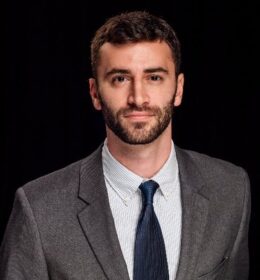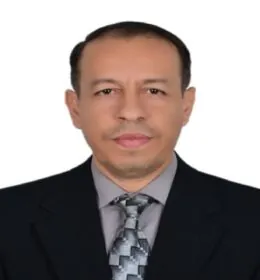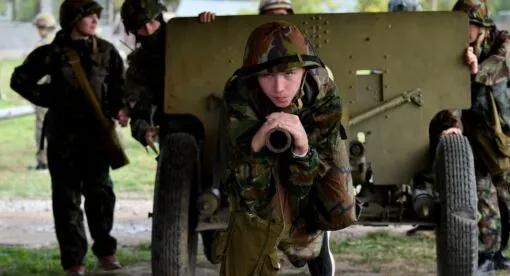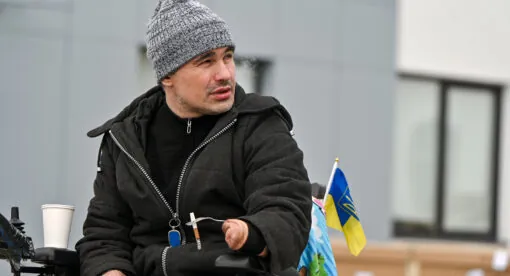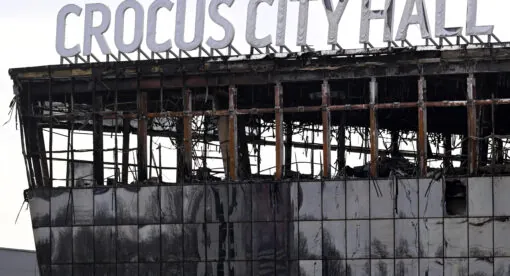In today’s Contours episode, Senior Director Eugene Chausovsky talks with New Lines’ non-resident senior fellow Chaouki Ghenai about his experience at the COP28 summit and his thoughts on the future of climate policy.
Eugene Chausovsky:
Hello everyone, and thank you for joining us for the New Lines Institute for Strategy and Policy Contours podcast series. I’m your guest host for today, Eugene Chausovsky, and I will be talking to Chaouki Ghenai, our Non-Resident Senior Fellow for Energy Strategy and Policy, about the global climate transition.
In addition to his role at New Lines, Chaouki is a professor at the Sustainable and Renewable Energy Engineering Department at the University of Sharjah in the United Arab Emirates and the coordinator of the Sustainable Energy Development Research Group at the Research Institute of Science and Engineering. Chaouki is also chair of the Energy and Climate Change Sustainability Office at the university. So Chaouki, you recently attended and participated in the COP28 UN Climate Change Conference, which is the world’s most important annual gathering when it comes to tackling global climate change. This year’s summit, which was held in Dubai from November 30th through December 12th, was hailed as a historic one by COP28 President Sultan Al-Jaber as it was the first time that nearly 200 countries reached a deal to transition away from fossil fuels. Can you explain the details of the agreement and why it is so significant?
Chaouki Ghenai:
Yes. Thank you so much, Eugene. Hello everyone. My name is Chaouki Ghenai. Yes, I think we can start maybe with the most important deals or agreement reached during the COP28. As you know, this is one of the important conference of parties or summits that is organized every year to tackle this big challenge that we have, the challenge with energy and also with climate change, how we can reduce the greenhouse gas emission and to reach the net-zero emission by 2050. And this is a problem, it’s a global challenge, a global problem, so we have to work together to solve this problem.
So, during this COP28 event that was organized here in Dubai, United Arab Emirates, from November 30th to December 12th, they had different zones, blue zone, green zone, where they had different activities. In the blue zone it was mainly for the leaders, the United Nations delegates, and the green zone was open for the public and also for scientists, for businessmen and the staff to tackle this kind of big challenge that we have with climate change.
But yeah, we had several activities during these days, but I would just focus right now on the main deals that reached during this COP28. The first one is, as you know, during the Paris Agreement in COP28 in 2015, they set the target to reach the average temperature increase about 1.5 degrees globally, and to reach these goals, you need to reduce greenhouse gases using clean energy technologies. One of the important deals that has been reached during the COP28 is I think to triple the renewable energy, triple the renewable energy. So we need to increase the capacity of the renewable energy by 2030. So, they set the target and increase to 11,000 gigawatt by 2030. This represents three times the actual capacity of the renewable energy, which is very important. So this will help to use clean energy technologies like solar PV, wind, hydro, clean power system to reduce the carbon footprint, and this will help to reach the climate targets.
So this is very important. That’s the first one. The second one is with respect to energy efficiency. See, what it has been reached also during this COP is to double the efficiency of the energy system by 2030. So, they increase the percentage every year, I think it was 2% per year in increase of energy efficiency. Now they increase it to 4%. So this will help to double the efficiency of the energy system by 2030. This is also very important. This will help to reduce also the greenhouse gas emission in addition to the renewable energy efficiency is very also important. Another deal that has been reached during this COP28 is the loss and damage fund. It was decided to establish a loss and damage funds to support vulnerable countries. They had the pledge to raise about, I think what they did, they were able to collect about $700 million.
This will come from the developed countries to help with the loss and damage funds. This is the funds that will help the country. This is mainly for climate adaptation, to make sure that this developing country, they have enough funds to tackle this problem or the disaster caused by the climate change. Another deal, it was the phase down of the coal. They didn’t talk about phase outs, but phase down is to reduce the amount of coal that’s used by several countries to produce electrical power. Another important one, in addition to the greenhouse gas emission, the CO2, the oil and gas company, also, they made the pledge to reduce the methane emission because methane is one of the species responsible for the climate change. And they decided these big companies, I think more than 50 different companies to reduce it to 0.2%. That means the CH4, the methane released from the oil and gas production.
So this is also very important in addition to the renewable energy efficiency and the efficiency reducing also the methane emitted to the environment is very important to tackle this problem of climate change. In addition to that, also they had the pledge for the global cooling pledge, which is the reduce energy use and also the greenhouse gas emission for the cooling of the buildings by developing more efficient energy system for cooling the building, reducing the emission from the refrigerant that we use for air conditioning systems. And the pledge was to reduce it by 68% by 2050 or so. So these are some examples about the main, I think, agreements or the main deals reached during the COP28. And this is very important because this will help to tackle this problem of climate change and to reach the net-zero emission by 2050.
Eugene Chausovsky:
Great. Thanks very much Chaouki. It’s a very comprehensive overview of some of the main pledges and agreements that were reached at COP28. So I’m very curious, besides kind of these broader agreements that were reached at the summit, when it comes to your own participation at COP28, what were some of the main highlights from your own personal experience there?
Chaouki Ghenai:
Yes, it was a really very good experience. This is my first COP I think that I participate, I think in this big summit about climate change. And it was very good experience. We had, I think the University of Sharjah, we had our booth at the Ministry of Education for the whole event from November 30th to December 12th. So we participate with different activities with the Ministry of Education. So they had what they call Green Education Hubs to talk about developing sustainable practices at the universities with respect to educational program, research, developing sustainability practice at university campus with respect to waste management, transportation, energy and climate change, water management, developing some desalination system at the university campus is developing some sustainability practices at universities. So this is one of them. The second activities, it was with the Ministry of Climate Change and Environment also here in UAE, where we had several activities for presentation workshop and also some activities with the students.
Yes, I think for some of the activities with the Ministry of Education, we had one workshop and one plenary session, and we had its Global Inter-University Forum on Sustainability. So we had faculties from University of Sharjah. I brought several leaders from the sustainability office to talk about the experience that we have at the University of Sharjah. University of Sharjah is the number one university in United Arab Emirates with respect to the ranking, with respect to sustainability. So we started six years ago, we developed a program to integrate the sustainability practices at the University of Sharjah. And students, faculty, and staff are part of these sustainability activities. So during this Global Inter-University Forum, we gave them some examples about sustainability practices. But what’s good about this workshop and plenary session also, we did it in collaboration with UCLA, University of California, Los Angeles, and also Oxford.
So we brought also some faculties, some big names, I think, from USA, the speaker from the California Senate. We brought one senators, UCLA or University of Los Angeles Water and Power Department. And to get the experience that we had by developing, for example in Los Angeles – they’re working on developing, going with 100% renewable for power generation in Los Angeles – to talk about the experiences that they had with sustainability, not only here in UAE, but from USA and from UK. So we had very good workshop and plenary sessions and people, they liked this workshop. See what we discussed this, for example, we had some examples about what we are doing at the University of Sharjah with the water management, how we can manage the water here at the University of Sharjah. Waste management, the waste management practice that we are using at the University of Sharjah. Energy and climate change, what type of energy efficiency system we’re using, what type of renewable energy system we’re implementing at university campus with respect to the transportation.
Also, what type of sustainable transportation we’re using at the University of Sharjah. Also, with respect to, we are using the salination system here at the university campus. We have a sustainable garden at the university where we are using solar PV to provide electrical power needed for the garden. And we’re using a desalination system to get fresh water needed to grow the plants. And we talked also about educational programs that we have at University of Sharjah. So we have more than 24% of the total courses from the university included some sustainability topics. This is very important because that’s what we are doing with this ranking. It will help us to see where we are compared to the other university all over the world and start to integrate more sustainability courses in our curricula. And also, we talked about a sustainability research program that we have at the University of Sharjah.
So this is what we covered from our side, from UCLA. We had also a group from the UCLA. They are working on indigenous people, the migrant people, and how these people are important also for tackling this problem of climate change. And they talk about the different activities that they have in USA, especially collecting some money to support some project in this kind of for indigenous people, for migrant people because they should be part of the solution that we need for the climate change. So this is for a workshop and the plenary session.
And also we organized the climate simulation with role playing with the students. So then this one was organized, the Ministry of Environment and Climate Change, where we send an invitation to a student and we form different groups of students, say six different tables. We put four to six students in each table. And we start, first of all, giving them some information, say what the student did. They’re doing climate simulation. So they use a software, en-ROADS, to simulate climate actions. They can use interactive software to start taking actions. We tell them what’s the problem, is the problem in the greenhouse gas emission because we’re consuming a lot of fossil fuel. We have a target based on Paris Agreement that we want to reach by 2050 or the end of the century of average temperature decrease of 1.5 degrees Celsius. And the students start to explore different technologies using renewables, using nuclear, using electrification, using energy efficiency, reducing the methane from agricultural activities using carbon capture and storage technologies. So they explore the use of different technologies, different policies, and they start to come up with a scenario to tackle this problem of climate change. And they were able to come up with a solution to see, and they can see exactly what are the impact.
And it was an interactive session where we have different group represented, different energy sector group representing maybe the fossil fuel like coal, oil, and natural gas. Another group representing the renewable energy, the third group representing maybe group from electrification or energy efficiency. Another group relate to carbon taxes. So we form a different group, and so we did some simulation using the software, and we had some discussions.
It’s like we went through two different rounds. The first round, it will be modeling and simulation analysis to come up with the scenarios to tackle this problem of climate change, to reach the goal of 1.5 degree Celsius by the end of the century. And the second round will be the discussion between the two groups and to come up with some negotiation between the two groups. And at the end we come up with one scenario to tackle this challenge. It was very interesting the session with the students, because as you know, during the COP28 for this year, I think we had one day was dedicated for the youth, for education, for children. And so these are the future leaders, some of them are future leaders that will tackle this problem of climate change. And they were involved during these activities for the COP28. So these are an overview of some of the activities that we had for the COP28.
Eugene Chausovsky:
Great. Thanks so much, Chaouki. Yes, doing these types of climate simulations is very important, especially as you mentioned with the younger population as this will become an increasingly significant, impactful issue for all of our lives moving forward.
So just to pivot a little bit, one key issue that you have recently written about for New Lines when it comes to the climate transition is about climate justice and equity. And I was wondering if you could just explain the importance of this topic, how, if at all, it was discussed during COP28 and some of the policy recommendations that you’ve outlined for policymakers in the U.S. and around the world on this issue.
Chaouki Ghenai:
Yes, thank you so much. Yeah, this is very important. I think we’re talking about the energy transition, which is very important, climate action also what we need to do with respect to the policies, the innovation technology that is needed also to tackle this problem because we need innovative technologies. For example, now we’re talking about green hydrogen, green ammonia. These are some alternative fuels that we need in the future, maybe new, maybe breakthrough through nuclear, maybe power from the smaller reactors or modular reactors. So these are all important policies. Business models, technologies are important to tackle this problem. But another problem, this is mainly needed for what we call climate mitigation. So mitigation we talk about mainly how we can reduce the greenhouse gas emissions. So we have to work a lot. And this is the deals that we discussed at the beginning by tripling, for example, the renewable energy increasing or doubling the energy efficiency by 2030.
These are very, very important I think, to tackle this problem. But there is another problem with climate adaptation because some of the countries, especially the poor country that’s suffering from this big problem that we have with the climate change because of the greenhouse gas emission, as you saw maybe in the recent years, last summer, for example, we have a record of fires. We had hurricanes, flooding and we have different weather disaster that can happen because of this climate change and also an increase of greenhouse gas emission that is coming mainly from fossil fuels. And countries that are suffering more from this disaster, some of that are poor countries. So you don’t have the funding to adapt to this kind of disaster.
So the idea of climate justice and equity, this is, I think it was discussed also during the COP28, and they already collected a loss and damage funds that can support vulnerable countries. So they made a pledge by the developed country, 700 billions for loss and damage. So we need this money to be distributed to these poor countries that are suffering more from this climate change. And also these countries, they don’t have the funding to go with, for example, developing this kind of renewable energy system because some of them are costly, they’re expensive. And say, as you know, SDG seven, Sustainable Development Goal number seven from the United Nations, says we need to develop clean and affordable energy. So we need and clean energy. We need to develop clean energy system, clean power, but it should be affordable also, especially the poorest countries should be afford to have this kind of clean energy technology. So the idea of climate justice and equity is to collect some funding. So they have to develop a framework or a mechanism to see who will be contributing to these funds as mainly it would be from developed countries because some of this developed countries are responsible for this climate change, and they’re producing a lot of CO2 emissions. And after that, say who will contribute?
And after that, they have to find a mechanism how to distribute this funding to these countries. So when there is a disaster, how they are going to distribute this funding. So this is very important, and climate justice and equity is very important, and developing this kind of funds will help to support the poorest countries that are suffering from this climate change. And it was discussed I think, during the COP28, but now we need to see what they’re going to do in the next year or two.
Eugene Chausovsky:
Understood. Thanks Chaouki. So despite the agreements that you’ve already discussed that were reached at COP28 on everything from the tripling the renewable energy capacity, energy efficiency, the phase down of fossil fuels, and just as you mentioned, the loss and damage fund, which still needs to play out. I think that the final text of the summit has still had some criticism from many climate activists and even some member states like some of the small island nations as essentially not doing enough to address the global climate challenge and that there’s a lot of loopholes that are contained in some of these agreements. So I was curious, what do you see moving forward as the biggest obstacles to this climate transition and fighting climate change? And what would you look at as measures of real progress into the future?
Chaouki Ghenai:
Yeah, this is very important. I think as we mentioned at the beginning, I think we had important deals and pledges that were made during the COP28. This is in the paper, but now we need actions. I think when you talk about tripling the renewable energy by 2030, so you’re going from maybe 4,000 gigawatts to 11,000 gigawatts. It’s not easy to reach this one. So they need an effort to reach it. So the pledge, one of the challenges, how you are going to reach this one? Because yes, we are developing solar and wind, but you need more funding. And as I said, some of the developed country maybe will be able to increase the renewable.
But there are some countries, because as I said, some of the technologies that we have renewable, they’re not affordable yet. We’re talking about solar PV, the wind. I’m talking about large scale renewable energy systems. We’re talking about green hydrogen, for example, blue hydrogen. So you need also some funding to support this kind of project. So the challenge is maybe how the funding needed to develop this kind of technology at the large scale and how you can reach the goals. So this is very important policies.
So you need to develop policies, strategies to reach these goals, and you have to put clear key performance indicator that will help you how this country are doing with respect to this pledge, especially for renewable global energy efficiency. And we talked also about oil and gas company, they made a pledge to reduce to 0.2% of the oil gas company because as you know the market, it’s dynamic. It’s changing. I think you can make a pledge now, but with the change in the future, this company can change their mindset. They will continue to burn, maybe oil, more gas. And so you will never reach the goal that you said from the beginning.
The other challenges, as I said, is the funding. As I said, they make the pledge to collect $700 million I think for the loss and damages. But as I said, they have to develop a mechanism, a framework to see how you can develop these strategies for collecting of the funds, for the distribution of funds among all these countries, especially the developing country that are suffering more from this climate change.
I think the other, as I said, I mentioned the cost, but if I can mention maybe the example for transportation sector, I think we need to increase the number of electrical vehicles, for example, in the road. And this one also, it’s the challenge is the cost. Let’s say the cost. Also, it’s not affordable, this kind of electrical vehicles. So we need more incentives, we need more policies, we need help from the governments.
And we need, as I said, a collaboration, collaboration because this is a big problem at the global level. It’s a world problem. So we need to work together to solve this problem. And also we need to find a mechanism how we can do it. So we need a collaboration between the governments, between the industry and sector. Higher education institutions, research institutions are important also. And also we need the involvement of the community. The community should also be involved in this kind of collaboration. Plus we need international collaboration also to develop maybe international partnership between different countries.
As I said, the deals reached during the COP are very good, but I think there will be a lot of questions on the actions that will be made. So we need to, as I said, that’s what’s good. We have this COP28 every year. So you have to see the progress. We made the pledge this year. And what will be the progress in COP28? You have to set the clear key performance indicators, and we need the support. I think, as I said, financial support. We need the new policies. We need also innovative technologies because we are talking about tripling the renewable energy.
For example, by 2030, we need the more efficient renewable energy system. So if we take the example of solar PV, for example, the efficiency is still low, the average is about 20% or so. So we need more efficient solar panels that has maybe high efficiency. How we can do it? Maybe we need to work on developing new technologies for converting the solar energy to electrical power. Then maybe developing a new type of materials for solar PV. So innovation technology also will play an important role, I think, for tackling this problem of energy and climate change.
Eugene Chausovsky:
Great. Thank you very much Chaouki. Well, one issue that I would add, in addition to everything that you’ve mentioned, are all of the geopolitical challenges around the world. We’re seeing the conflicts in Ukraine, the conflicts in the Middle East, an emerging competition between China and the U.S. All of these can and do have important impacts, not only on energy security, but also the global climate transition. But as you said, climate change is an issue that impacts all of humanity. So we really need to work together in order to really address this problem. So with that, I think we’ll conclude this podcast. I just want to say thank you very much to Chaouki for providing these valuable insights. And thank you all for listening. You can find more analysis related to global energy dynamics and the climate transition on our website at newlinesinstitute.org. Take care, and all the best.
Chaouki Ghenai:
Thank you so much. Thank you.

